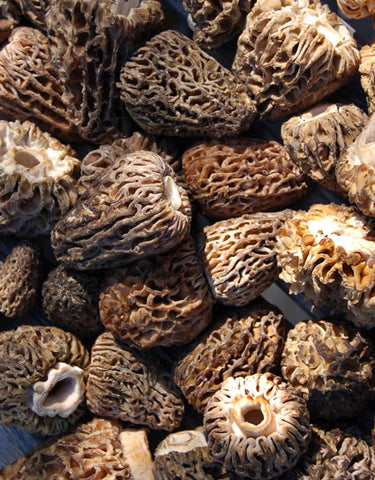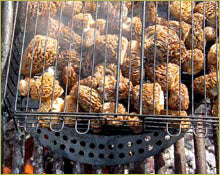Morel Mushrooms
 Morchella esculenta; M. elata, M. conica
Morchella esculenta; M. elata, M. conica
This may be America's most sought after mushroom. If you've tasted them, you know why. Their rich beefy flavor seduces all but the dullest palettes. They are the tricksters of the wild mushroom world, often defying the best mushroom pickers' wiliest hunts.
While chanterelles, porcini, black trumpets and many others are mycorrhizal (symbiotic with a specific tree and repeating fruiting most years), morels are saprophytic. Most morels grow independently with odd tastes for their preferences in decaying matter.
Morels can be messily grouped into three general species complexes and growing behaviors. Morels are notoriously difficult to identify to exact species. Even noted scientists like Nancy Weber say "uncle" and walk away from specifying many morels species. We commercial hunters sort them into "naturals", "burn" morels, and the magnificent lesser-known gray morels of summer.
The "naturals" are the best known group. They include the beloved blonde morels (more common in the Midwest) Morchella esculeta, and the black morel complex. As a general rule, these morels have thick or double walls. You'll see this when you look at a cross section of the cut stem. These "naturals" are fleshier and unfortunately at times house wormy visitors. They're found in the Mid-West, and in disturbed ground habitats elsewhere.
Most morels from forest fires are regarded in the commercial world as "conicas". These erupt after forest fires, often in great numbers. Pointy conicas are on the small side, are very thin-walled, and are generally worm free. As the heat of summer comes on, the massive and little known gray morel (Morchella tomentosa) can appear later in the same forest fire zones that the conicas have been fruiting in. These double or even triple-walled morels are the favorites of virtually all commercial pickers I know, including me. They are ideal for stuffing. I've put chefs through blind tastings of various morel types. Gray morels always win, followed by conicas, and then "naturals".
|
ALERT ! ! NEVER EAT UNCOOKED MORELS ! They contain a sickening compound that is volatized in the cooking process. You really don't want to spend time deliberately inhaling these aromas while cooking morels either. Cleaning Cut most of the stem off and look carefully for worms. The stems can be sandy or ashy if they’re from a fire. Rinse each and give a swirl of water on the inside too (they’re hollow) then place on a towel to dry a bit. DON’T soak in water. Cook the smaller ones whole, and cut larger ones in half like little boats, or even slice whole across to make morel rings. Since morels are totally hollow, stuffing them is always a gorgeous plan. If worms are present, there is no secret panacea to banish them. The best of imperfect options is to put the mushrooms on a tray in the freezer for 15 minutes, then remove before frozen. The worms often crawl out of their hiding places. Hunting & Harvesting These tricky darlings grow wherever they want. They famously grow in abundance after forest fires in the spring following the previous summer's fires. In the Midwest, people haunt dying elm trees, old apple orchards, and swales of ash and basswood. Old logging skids trails, raked campgrounds, logged areas and anywhere ground has been disturbed by equipment are also likely hunting areas. Seasonality They are the mushroom emblem of spring. The season ranges from April to as late as July for the unusual gray morel. The gray morel (link to store item) is the tastiest of all morels. See The Wild Table chapter on the fascinating gray morel, page 87. Cooking The only bad way to cook morels is to undercook them. NEVER EAT UNCOOKED MORELS ! I’m serious; they will make you quite ill. Morels contain a nasty compound that volatilizes in the cooking process. You really DO want your morels well cooked. Now after that Mommy-like warning, you can go wild in the kitchen grilling, sautéing, roasting, or stuffing this utterly delicious mushroom. I’m partial to smaller morels simply tossed in garlic butter and basket grilled. The larger ones can be stuffed with all manner of scrumptious meats or cheeses. See The Wild Table morel and gray morel chapters.
Preservation Morels are possibly the best of all dried morels. Who doesn't want to have morels in the pantry at all times? Our small dried morel oval equals close to ¾ pound of fresh morels, and the larger container equals well over a pound of fresh. They rehydrate spectacularly. I know a few chefs that prefer the dry to fresh. One pound of dry morels equals 8-10 pounds of fresh. Storage Don’t wait long to eat them, but who would want to? After cleaning, use them within a couple of days. The “burn” ( those from fires) can easily last five days. |

